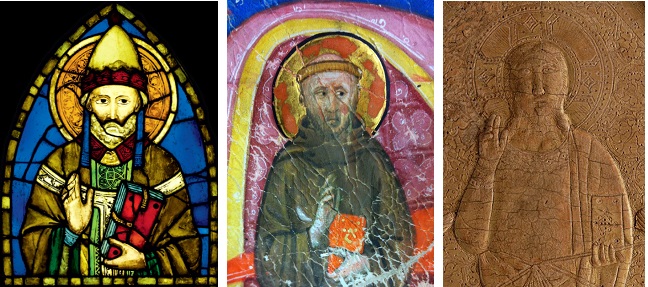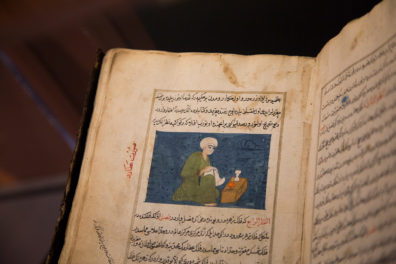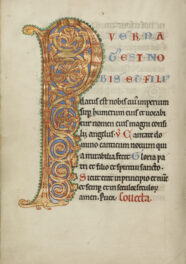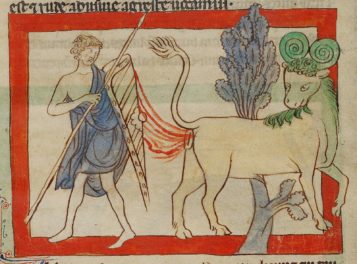
Left: A Bust of a Pope-Saint, about 1310-1315, Pacino di Bonaguida. Pot-metal and clear glass, black and brown vitreous paint, 35 13/16 x 26 3/8 in. Museo dell’Opera di Santa Croce, Fondo Edifici di Culto, Ministero dell’Interno, Florence. Center: Saint Francis in Antiphonary, about 1320, Pacino di Bonaguida. Tempera colors and gold leaf on parchment, 20 ½ x 13 15/16in. Archivio di Santa Croce, Florence, Corale Q, fol. 121v (Photo: Bryan C. Keene). Right: Chiarito Tabernacle (detail), 1340s, Pacino di Bonaguida. Gilded gesso and tempera on panel, 39 7/8 x 44 11/16 in. The J. Paul Getty Museum, 85.PB.311
Over a year and a half ago, visitors to the Getty’s exhibition Florence at the Dawn of the Renaissance: Painting and Illumination, 1300-1350 were encouraged to spend time getting to know a fourteenth-century Florentine artist called Pacino di Bonaguida. The savvy head of an extremely productive workshop, Pacino was both a panel painter and manuscript illuminator who lived at the time of Giotto di Bondone and Dante Alighieri. Pacino’s career ran from about 1303 to about 1347, and during this rather long period he and his shop produced monumental altarpieces, intimate devotional panels, numerous choir book volumes, stained glass windows, and beautifully illuminated copies of Latin and vernacular literature, including current legal treatises and some of the earliest versions of the Divine Comedy. I still find myself marveling at this vast output and continually trying to better understand this relatively obscure individual.
The close of an exhibition does not mean that a curator’s research about the works of art comes to an end. In fact, exhibitions often spark new avenues of research because they provide a venue to study and appreciate objects brought together from collections around the world. The art of Pacino di Bonaguida was shared with almost 200,000 visitors in Los Angeles and in Toronto at our partner institution, the Art Gallery of Ontario (with their presentation of Revealing the Early Renaissance: Stories and Secrets in Florentine Art), and it is encouraging to know that Pacino is now officially considered a central figure in our understanding of Florentine workshop practices in the early Renaissance.
I recently was in Florence to continue the study of works by Pacino – marking another chapter in the ongoing relationship between the Getty and Florence. The Getty Foundation provided a grant that partially funded the conservation treatment of Giotto’s frescoes in the Peruzzi Chapel there, an intimate space that receives natural light through a set of stained glass windows by Pacino (they were moved here from a nearby chapel). Additionally, through its Panel Paintings Initiative the Foundation is currently supporting the restoration of Giorgio Vasari’s Last Supper, which was damaged along with numerous other works (including some by artists in Pacino’s orbit) in the catastrophic 1966 flood.
The Church of Santa Croce in Florence generously lent two extremely rare and exceptionally beautiful stained glass windows by Pacino to the exhibitions at the Getty and the Art Gallery of Ontario, and a friend and colleague there asked me to share some new reflections about the windows in relation to other works produced by Pacino at Santa Croce.
Please see my post on the blog of Santa Croce in Florence to learn what I found.





Comments on this post are now closed.